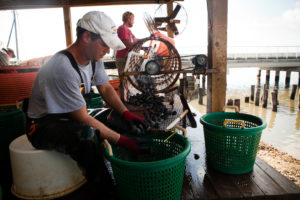Skilled professionals diligently handle, pick, and pack shellfish products to ensure quality and safety for consumers. Historically, Cedar Key was a hub for blue crab processing but now clams are the major seafood processed locally.
Offloading 
In Florida, all commercial seafood landings are sold first to licensed wholesalers before being marketed and sold to the public. Wild-harvested shellfish are reported to the Florida Fish and Wildlife Conservation Commission through “trip tickets”, which track information about the amount of catch and other details about each fishing trip. This data is used in fisheries management. Aquacultured shellfish landings are reported to the Florida Department of Agriculture and Consumer Services. Offloading catch at a processor, thus, involves some paperwork as well as some heavy lifting.
Preparation
Some shellfish are sold live (e.g., clams), others are sold pre-cooked (e.g., stone crabs), and still others can be purchased either live or canned (e.g., oysters, blue crabs). No matter how they are sold, all shellfish require some level of handling before packing. From simply cleaning the exterior of the shell to cooking, removing unwanted parts, rapid cooling, or separation of meat grades, great care is taken to ensure rapid and safe processing of all shellfish species.
Grading & Packing 
The final steps before shipping to a seafood market or restaurant near you, grading and packing are important quality assurance mechanisms. Shellfish products are often graded by size (e.g., clams, shrimp, stone crab claws) or meat type (blue crab claws vs. lump meat). Strict controls on temperature are applied to ensure food safety. Canned meats are often pasteurized for added safety. Refrigeration, chain of custody tracking, and rapid processing are safety protocols applied to shellfish that are sold live.


